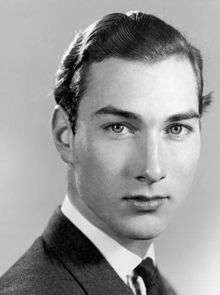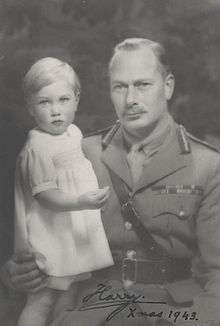Prince William of Gloucester
| Prince William | |||||
|---|---|---|---|---|---|
 Prince William in 1962 | |||||
| Born |
18 December 1941 Hadley Common, Barnet, Hertfordshire | ||||
| Died |
28 August 1972 (aged 30) Halfpenny Green, Staffordshire | ||||
| Burial |
2 September 1972 Frogmore, Windsor, Berkshire | ||||
| |||||
| House | Windsor | ||||
| Father | Prince Henry, Duke of Gloucester | ||||
| Mother | Lady Alice Christabel Montagu Douglas Scott | ||||
Prince William of Gloucester (William Henry Andrew Frederick; 18 December 1941 – 28 August 1972) was a grandson of King George V of the United Kingdom and cousin of Queen Elizabeth II.
A Cambridge graduate, he joined the Foreign and Commonwealth Office, serving in Lagos and Tokyo, before returning to take over royal duties. At this time, he was diagnosed with porphyria,[1] probably hereditary, but died at 30 in an air crash, while piloting his plane in a competition.
Early life

Prince William was born at Hadley Common,[2] Hertfordshire. His father was Prince Henry, Duke of Gloucester (1900–1974), the third eldest son of King George V and Queen Mary. His mother was Princess Alice, Duchess of Gloucester (1901–2004), the third daughter of the 7th Duke of Buccleuch.
He was baptised in the Private Chapel at Windsor Castle on 22 February 1942 by Cosmo Gordon Lang, Archbishop of Canterbury. His godparents were: King George VI (his paternal uncle); Queen Mary (his paternal grandmother); Princess Helena Victoria (his cousin); the Lady Margaret Hawkins (his maternal aunt); Major the Lord William Montagu Douglas Scott (his maternal uncle); and the Viscount Gort (who was unable to attend).
Because of the war, newspapers did not identify the actual location of the christening, and said instead that it took place at "a private chapel in the country".[3][4] In 1947, Prince William was a page boy for his cousin The Princess Elizabeth at her wedding to Philip, Duke of Edinburgh.[5] The other page boy was Prince Michael of Kent. In 1953, he attended the coronation of Elizabeth II.
Prince William spent his early childhood at Barnwell Manor in Northamptonshire and later in Australia, where his father served as Governor-General from 1945 to 1947. He received his education at Wellesley House School, a prep school at Broadstairs in Kent, then at Eton College. After leaving Eton in 1960, he went up to Magdalene College, Cambridge, to read history, graduating with a BA degree in 1963, subsequently raised to an MA (Cantab.) degree in 1968. After Cambridge, he spent a post-baccalaureate year at Stanford University, studying political science, American history, and business.
Career
After returning to Britain, he took a position with Lazards, a merchant bank.
Prince William was the second member of the British Royal Family to work in the civil service or the diplomatic service (the first was his uncle, Prince George, Duke of Kent, in the 1920s). He joined the Commonwealth Office in 1965 and was posted to Lagos as the third secretary at the British High Commission. In 1968, he transferred to Tokyo to accept the post of second secretary (commercial) in the British Embassy.
In 1970, the health of his father, the Duke of Gloucester, was beginning to fail and Prince William was diagnosed as suffering from porphyria. Prince William resigned from the diplomatic service and returned to Britain. For the next two years, he managed Barnwell Manor and began to carry out public duties as a member of the royal family.
Prince William served on some occasions as Counsellor of State in the absence of his cousin, the Queen.
Personal life
Shortly before transferring to Tokyo in August 1968, Prince William was examined by an RAF doctor, Henry Bellringer, at the request of the prince's mother. William told the doctor that he had suffered from fever and cutaneous hepatic symptoms, beginning in December 1965 and lasting several months. He had subsequently noticed that his skin was prone to a blistering rash, particularly on exposure to sunshine. Bellringer tentatively diagnosed porphyria, prescribed sunblock cream and gave him a medical warning card regarding the need to avoid certain medications. Although he was aware of the theory of the royal family's history of porphyria then being proposed by Professor Ida Macalpine and Dr Richard Hunter,[6] he stated he "tried not to let it influence him...with all the symptoms, I was left with little option but to diagnose the Prince's condition as porphyria." William was later examined by haematologists at Addenbrookes hospital in Cambridge and also by a Professor Ishihara in Tokyo, both of whom also concluded he was suffering from variegate porphyria, by then in remission.
.jpg)
A member of the British royal family being reliably diagnosed with porphyria subsequently added credence to the theory—first proposed by Professor Macalpine in the late 1960s—that porphyria was the source of the ill-health of both Mary, Queen of Scots (an ancestor of both of William's parents) and of George III and that the disorder had been inherited by some members of the royal families of the UK, Prussia and several minor German dukedoms and principalities.[7]
Although details of Prince William's personal life have remained private, an interview with Zsuzsi Starkloff, a former model and stewardess, published by the Daily Mail on 24 August 2012 asserts that William had a long-standing relationship with her and wanted to marry her; however, she alleges that because she was twice divorced and a mother of two small children, William's family refused to acknowledge or accept their relationship. The article speculates further that Starkloff met with displeasure from courtiers, because she was Jewish and Hungarian. According to Starkloff, William continued to see her until his accidental death in 1972.[8]
The relationship with Zsuzsi Starkloff was further reported in the 2015 Channel 4 TV documentary, The Other Prince William. [9]
Death
A licensed pilot and President of the British Light Aviation Centre,[10] Prince William owned several aircraft and competed in amateur air show races. In August 1972, he was competing in the Goodyear International Air Trophy at Halfpenny Green, near Wolverhampton, with Vyrell Mitchell—a pilot with whom the prince had often raced—listed as a passenger. Shortly after their takeoff and at a very low altitude, the Piper Cherokee banked abruptly to port, with an extreme increase in the rate of turn and corresponding loss of altitude; the wing hit a tree and sheared off, and the out-of-control plane flipped over and crashed into an earthen bank, bursting into flames. Prince William and Mitchell were killed.[11][12] The crash happened before 30,000 spectators, the fire took two hours to control, and the bodies were identified at inquest next day from dental records.[10]
His father, Prince Henry, was in such poor health at the time of his death that his mother hesitated whether to tell him. She later admitted in her memoirs that she did not, but that he may have learned of their son's death from television coverage.
Prince William was buried in the Royal Burial Ground, Frogmore. The comprehensive school in Oundle, which he opened in 1971, was renamed Prince William School in his memory.
Prince William was the heir apparent of his father's peerages, Duke of Gloucester, Earl of Ulster, and Baron Culloden. Upon his death, his younger brother Prince Richard of Gloucester became heir apparent, and succeeded to these peerages in 1974. Prince William was the first grandchild of King George V and Queen Mary to die.
He shared a close relationship with Charles, Prince of Wales, his seven-years-younger first cousin once removed. The Prince of Wales named his first son, Prince William, born in 1982, after him.[13]
Titles, styles, honours and arms

Titles and styles
- 18 December 1941 – 28 August 1972: His Royal Highness Prince William of Gloucester
In full: His Royal Highness Prince William Henry Andrew Frederick of Gloucester.
Honours
- Counsellor of State, 1962–1971
Arms
For his 21st birthday, in 1962, Prince William was granted the use of the Royal Arms, differenced with a label argent of five points, the outer pair and central point bearing lions gules, the inner pair crosses gules.[14]
Ancestry
References
- ↑ https://books.google.com/books?id=OckqbM7hcGAC&pg=PA21
- ↑ Royal Children by Charles Kidd & Patrick Montague-Smith
- ↑ The Times, 23 February 1942
- ↑ Yvonne's Royalty Home Page — Royal Christenings
- ↑ Royal.gov.uk – 60 Facts, Fact 9 Archived March 3, 2016, at the Wayback Machine.
- ↑ Macalpine I, Hunter R (1966). "The "Insanity" of King George III: a Classic Case of Porphyria" (PDF). British Medical Journal. 1 (5479): 65–71. doi:10.1136/bmj.1.5479.65. PMC 1843211
 . PMID 5323262. Retrieved 28 April 2011.
. PMID 5323262. Retrieved 28 April 2011. - ↑ Rohl, John C.G. et al., Purple Secret London:Bantam Press 1998
- ↑ Wilson, Christopher (24 August 2012). "How the Queen sabotaged my passionate affair with her cousin". Daily Mail. Retrieved 2 September 2012.
- ↑ "The Other Prince William". Channel 4.
- 1 2 "Light is shed on death of prince". Shropshire Star. 2 November 2015. p. 8.Report by Adam Burling, Comment and Analysis.
- ↑ "Civil Aircraft Accident Report 7/73, Department of Trade and Industry" (PDF). Retrieved 28 August 2013.
- ↑ "1972: Prince William killed in plane crash". On This Day. BBC News. 28 August 1972. Retrieved 28 April 2011.
- ↑ The other Prince William: The uncanny parallels between Wills and the dashing but doomed cousin in whose memory he was named, Daily Mail, 08/11/2011
- ↑ Heraldica – British Royal Cadency
.svg.png)